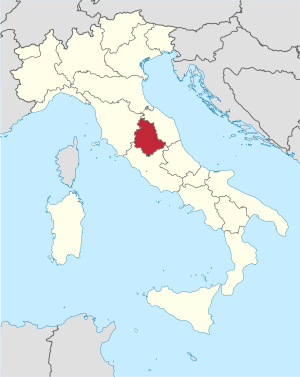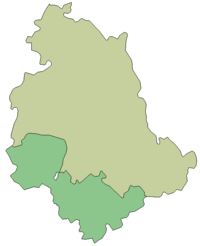Umbria facts for kids
Quick facts for kids
Umbria
|
|||
|---|---|---|---|
|
|||
 |
|||
| Country | Italy | ||
| Capital | Perugia | ||
| Area | |||
| • Total | 8,464.33 km2 (3,268.10 sq mi) | ||
| Population
(1 January 2017)
|
|||
| • Total | 888,908 | ||
| • Density | 105.01812/km2 (271.99567/sq mi) | ||
| Demonym(s) | umbro | ||
| Time zone | UTC+1 (CET) | ||
| • Summer (DST) | UTC+2 (CEST) | ||
| GDP/ Nominal | € 21.8 billion (2008) | ||
| NUTS Region | ITE3 | ||
| Website | www.regione.umbria.it | ||
Umbria is a beautiful region located right in the middle of Italy. It's one of the twenty regions that make up the country. Even though it's one of the smallest regions in Italy, it's packed with history and natural beauty. Its main city, or capital, is Perugia.
What makes Umbria special is that it's the only region in Italy that doesn't have a coastline. This means it's completely surrounded by land! It also doesn't share a border with any other country.
Contents
Exploring Umbria's Geography
Umbria is found in Central Italy. It covers an area of about 8,464 square kilometers (3,268 square miles). Imagine a place with no ocean, but lots of green hills and valleys!
 |
Tuscany | Marche |  |
|
| Tuscany | Marche | |||
| Lazio | Lazio |
Umbria shares its borders with a few other Italian regions. To the east and northeast, you'll find Marche. To the west and northwest, it's bordered by Tuscany. And to the south and southwest, it meets Lazio.
Rivers and Lakes of Umbria
The most important river flowing through Umbria is the mighty Tiber. Other significant rivers include the Nera, Paglia, Topino, Chiascio, and Nestore. These rivers help shape the landscape and provide water for the region.
Umbria is also home to Lake Trasimeno, which is the largest lake in the region. It's also one of the biggest lakes in all of Italy! It's a great spot for nature and water activities.
Umbria's Highest Mountains
The highest point in Umbria is Cima del Redentore. This mountain is part of the Sibillini Mountains, also known as Monti Sibillini in Italian. Cima del Redentore stands tall at 2,448 meters (8,031 feet) above sea level.
Provinces of Umbria
Umbria is divided into two main areas called provinces. These are like large counties that help organize the region.
The two provinces are:
Each province has its own capital city and many smaller towns, called comuni.
| Province | Abbreviation | Capital | Area (km²) |
Population (1 January 2017) |
Density (inh./km²) |
Comuni |
|---|---|---|---|---|---|---|
| Perugia | PG | Perugia | 6,337.15 | 662,110 | 104.5 | 59 |
| Terni | TR | Terni | 2,127.18 | 229,071 | 107.7 | 33 |
| Total | 8,464.33 | 888,908 | 105.0 | 92 | ||
Biggest Cities in Umbria
Here are the 10 comuni (cities or towns) in Umbria with the most people living in them:
| No. | City/Town | Province | Population (2017) |
Area (km2) |
Density (people/km2) |
|---|---|---|---|---|---|
| 1 | Perugia | PG | 166,676 | 449.51 | 370.8 |
| 2 | Terni | TR | 111,455 | 212.43 | 524.7 |
| 3 | Foligno | PG | 57,164 | 264.67 | 216.0 |
| 4 | Città di Castello | PG | 39,740 | 387.32 | 102.6 |
| 5 | Spoleto | PG | 38,035 | 348.14 | 109.3 |
| 6 | Gubbio | PG | 31,939 | 525.78 | 60.7 |
| 7 | Assisi | PG | 28,379 | 187.19 | 151.6 |
| 8 | Bastia Umbra | PG | 21,784 | 27.60 | 789.3 |
| 9 | Corciano | PG | 54,311 | 63.72 | 852.3 |
| 10 | Orvieto | TR | 21,349 | 281.27 | 75.9 |
| Provinces of Umbria |
|---|
| Perugia - Terni |
Images for kids
-
View of Assisi
See also
In Spanish: Umbría (Italia) para niños







